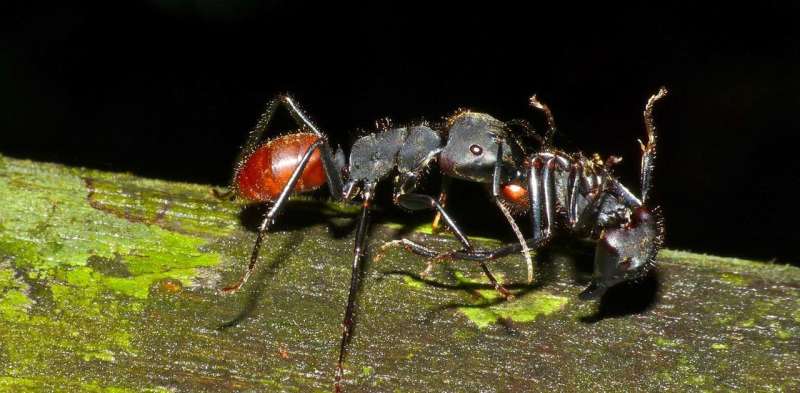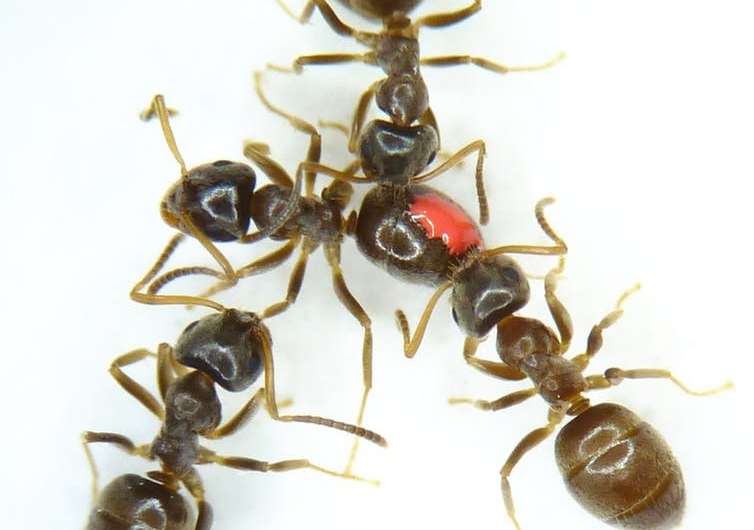Antibiotic resistance fight could get a little help from ants

The world is facing an antibiotics crisis. Due to overuse, many once-powerful drugs are now useless against certain strains of serious bacterial infections. So scientists are on the hunt for new ways to attack harmful microbes.
One possibility is to investigate how other species have evolved ways to defend themselves. A new study highlights how most ants, even from small colonies, produce antimicrobial chemicals in their bodily secretions. It also suggests those ants that don't make these substances are likely to have some other method of controlling bacteria that could be investigated. So perhaps the answer to antibiotic resistance is under our feet.
Like humans, the more than 12,000 species of ants are all highly social. This behaviour increases the chance that they come into to contact with germs. Comparable to our towns and cities, ant colonies take communal living to the next level, with up to tens of millions of individuals cohabiting in a single nest.
Colony survival depends on worker ants going out into the environment to collect food. Workers return to their densely inhabited nests loaded with food, but also harmful microbes. Returning workers then share their food and their germs through mouth-to-mouth feeding – essentially vomiting into each other's mouths.
If this wasn't enough, the warm, moist conditions in ants' nests make them ideal nurseries for disease-causing microbes. Finally, the members of almost all ants in a colony are related, so if one ant is susceptible to a germ, it is likely that many others will be, too.
Despite this longstanding threat of disease, ants are incredibly successful creatures. They dominate some environments and have diversified into thousands of species over 150m years of evolution. This suggests ants have found ways to deal with the high threat of disease. So what can we learn from them?
How ants deal with disease
Scientists have found that ants use a number of tricks to limit disease. Like humans, ants are exceptional cleaners. Many species have efficient waste-removal systems, ensuring diseased waste (including dead ants) is removed from the nest or contained in special chambers. They also regularly clean themselves and each other, and group together to disinfect contaminated ants.
But even with good hygiene habits, disease can still be an issue. Ants have evolved ways around this by using their own form of medicine. For example, some ants, when infected, eat toxins such as hydrogen peroxide to fight disease. Others collect conifer resin, which they incorporate into their nests as a preventative measure. Some species of ant are able to produce formic acid, which combines with the resin to form a potent antimicrobial agent.
We also know that ants also produce their own antimicrobials in bodily secretions. Now researchers have tried to work out what affects how these chemicals are made. In a new study published in the journal Royal Society Open Science, researchers from Arizona State University investigated the antimicrobial activity of 20 ant species in the US living in nests with between 80 and 220,000 inhabitants.

The researchers predicted that larger nest species would produce more effective antimicrobials, because of a greater risk of coming into contact with disease. Testing external secretions against Staphylococcus epidermidis, a common bacterium not known to cause disease, showed that 60% of the ant species produced secretions with antimicrobial activity. But, surprisingly, 40% didn't produce an antimicrobial that could kill the bacterium.
What's more, species in larger colonies were no more likely to have antimicrobial activity than small colonies. This is surprising as it is generally thought that disease is more likely to be spread in larger colonies. The authors suggest that the 40% of ants without antimicrobial activity have other methods of controlling the spread of bacteria. But we also don't know if these 40% produce antimicrobial agents that work against other microbes.
Antibiotics for the future?
This adds to the idea that ants could well be a good source of new antibiotics. Not only do ants produce their own antimicrobial agents, but they can also encourage other beneficial microbes to grow. For example, researchers recently discovered a bacterium living among one ant species that produces compounds capable of killing harmful bacteria resistant to conventional antibiotics, including the common superbug MRSA.
Millions of years of evolution in a high-risk environment have made ants a potential source of vital antimicrobials. These substances still need to be turned into effective drugs and then trialled in humans. But the more we learn about the strategies ants use to fight disease, the more likely we are to uncover new ways to deal with the threat of resistant bacteria and disease.
This article was originally published on The Conversation. Read the original article.![]()


















